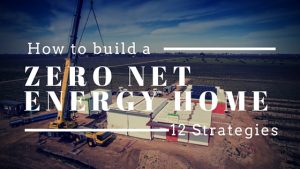
The premise of Zero Net Energy (ZNE) is simple: to build a home that produces as much energy as it consumes over the course of the year. The execution is more complex, requiring a synergistic blend of high performance design, advanced engineering and renewable energy technologies that use the earth’s natural resources to mutual advantage.
ZNE is the future, especially in California, which has set the goal of having all new residential construction meet ZNE standards by 2020—just four years away. The energy optimization strategies tested in River Vine can be replicated in future buildings, paving a path for progress by demonstrating how solar energy and energy-efficient components can work together to deliver ZNE-level performance.

2. Window Type and Placement
Multiple sources of natural light reduce the need for electricity. River Vine is 48% glass, with the largest floor-to-ceiling windows situated on the southside and paired with upper clerestory windows and Solatube skylights to admit sunlight at every level. Dual-glazing and low-E coating work in tandem with roof overhangs to control direct heat gain for interior comfort and energy efficiency.
3. Tight Building Envelope
A supertight structural shell prevents air and water infiltration from roof to footers. Fiberglass sheathing, gypsum-fiber roof boards and vapor permeable building wrap give River Vine a tight exterior seal that minimizes energy losses, while providing passive climate control. A conditioned crawl space prevents air from entering the house from below.
4. High R-Value Insulation
A high density insulation system achieves high R-value, air sealing, moisture control and added structural strength. Insulating River Vine’s ceilings, walls and floors significantly reduces the amount of heating and cooling needed, while keeping the home comfortable for occupants year-round.

6. Integrated Renewable Energy Systems
Networking multiple energy sources provides greater efficiency than that attainable by each individual system working independently. River Vine’s solar photovoltaic (PV) array integrates seamlessly with solar hot water and geothermal systems to harness both energy from the sun and energy stored in the earth.
7. Radiant Heating and Cooling
Heating and cooling a home is its biggest energy expense. Transferring heat from one place to another is far less costly than creating heat. River Vine uses a geothermal heat pump to circulate water through a ground loop, drawing stored heat from the earth and transferring it into the home via radiant flooring.
8. Natural Ventilation
Gravity-fed natural convection can passively cool a home, reducing total energy consumption by 10-30%. River Vine’s central core is designed to draw solar heat from the south-facing window wall, directing excess heat upward and out of the home through strategically placed auto-vents in the roof.
9. LED Lighting
Sunlight provides most of a ZNE home’s lighting during the day. When electric lights are needed, LEDs use less energy than CFLs and have a more natural tone, making them a more aesthetic option with a lower lifecycle cost. River Vine uses multi-level LED lighting for greater functionality and efficiency.
10. ENERGY STAR Appliances
ENERGY STAR models use 15% less energy than conventional appliances, but the best high efficiency appliances exceed that, using up to 50% less power and water. Label-shopping for appliances with the lowest kWh—the measure of annual energy use—allows River Vine to maximize savings with appliances on the cutting-edge of energy efficiency.
11. Automated Controls
Smart technology automates systems for optimized performance and energy savings. River Vine’s home automation includes programmable climate control, occupancy and light sensors, motorized window shades, automated ventilation and auto-detecting humidity sensors for occupant comfort and safety.
12. Energy Management System
Continuous energy tracking allows critical adjustments to be made to achieve ZNE goals. River Vine’s Energy Management System is state-of-the-art, monitoring the home’s energy production and usage in real-time and notifying homeowners when any component is not performing to modeled targets.
Learn more about River Vine’s energy-efficient products and integrated energy systems.



